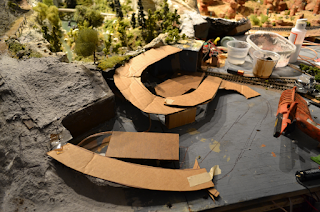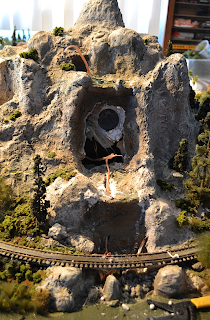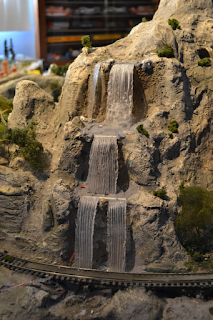The main section of Rainbow Ridge was planned out on paper for just about every detail. The Pack Mule area on the other hand was pretty much roughed in and the final decisions would wait until actual construction. Because of this, the Pack Mule area was first mocked-up in cardboard in order to figure out the layout of everything.
As seen in past posts, lighting adds another dimension to the layout and Rainbow Ridge is no exception. This part of the layout will feature probably half the lights on the layout just in itself. So, before hills could be put in, 12v bus wire was run to critical areas in the Pack Mule load/unload. This is also where the layout splits in half, so wiring can't be run from the other side of Rainbow Ridge.
Once the wires were run, aluminum foil hills were formed and covered in a shell of celluclay. At the time they were put in, the hills were as wet and soggy as a Anaheim rainy day.
The uncovered foil sections represent where the buildings will go.
Since it would take days for the celluclay to dry because of the high humidity, I changed gears and jumped to the other side of Rainbow Ridge: the train load/unload. This stage of construction is critical since any mistake now could be costly, since I can't just slap plaster and cover it with scenery (considering it's all buildings with hard edges). As a result, this area will be a slow process until all details are accounted for.
The first step is the platforms, for both the load/unload area and for the building facades across the track. These were cut from masonite and raised on spacers. This will allow for wires to run underneath for lighting in the buildings, light poles, and the sound speakers.
What's pretty amazing is this was done 7 years ago this month in 2005, but quite a bit more primitive.
Since wiring had to run to the Pack Mule area for lighting, the light package Beaver Valley was finalized.
The Marmot tunnel was also lit, with the usual all-LED lighting.
Speaking of the marmot tunnel, something peculiar has occurred at the prototype tunnel over in Anaheim...
Some fresh paint has been applied to the tunnel, however, this is simply no refurbishment. This is actually a color sample test for the upcoming lengthy Big Thunder Mountain rehab. After the rockwork job on Cars Land and the Matterhorn, Big Thunder should look fantastic. It's also nice that the ole relic is spruced up a bit, even if the whole thing isn't repainted.

























































